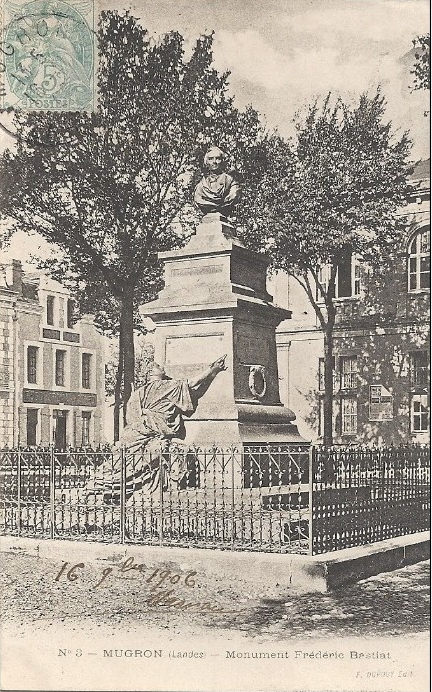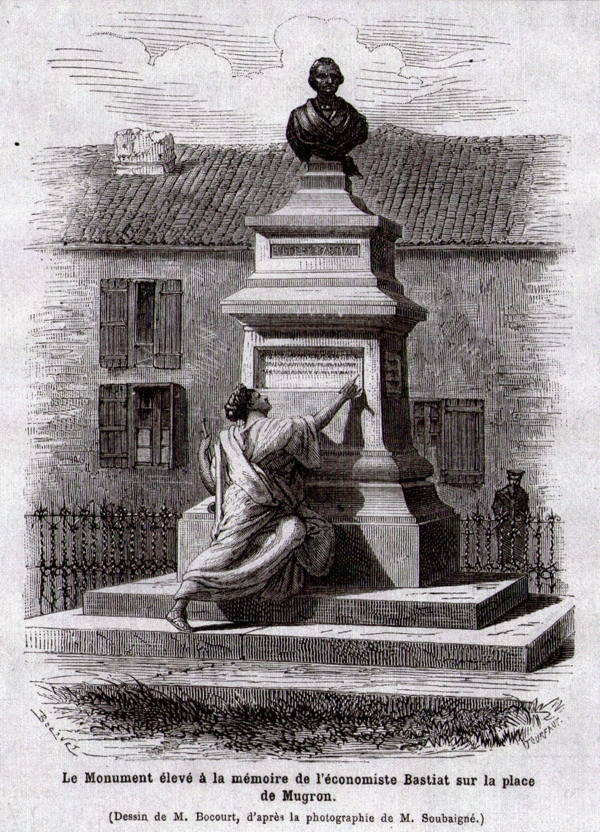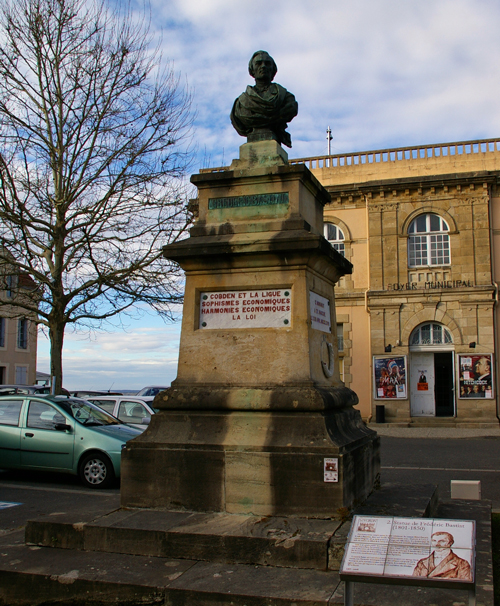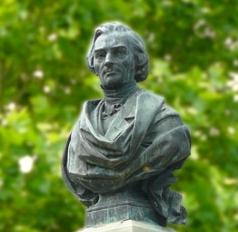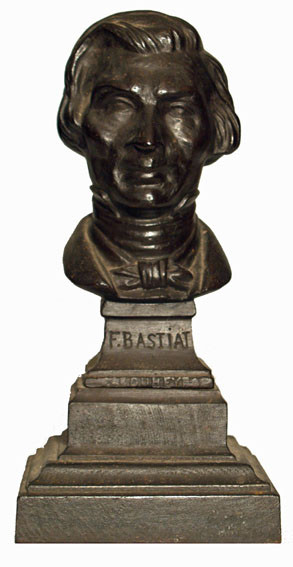(A Monument erected to the memory of Bastiat was unveiled in Mugron, 23 April, 1878.)
After Bastiat’s death on Christmas Eve 1850 his friend Prosper Paillottet went through Bastiat’s papers in order to get them organized for a printing of his collected works. Six volumes of the first edition appeared in 1854-55. A second edition with an additional 7th volume appeared in 1862-64 and it was this edition which was reprinted several times during the 19th century. Many of Bastiat’s other single volume works were kept in print by the Guillaumin publishing firm during this time as well, especially the Economic Harmonies. His friends and colleagues wanted to do more for his memory than to just keep his books in print. It was decided to raise money (privately of course) to design a statue of him which would be erected in his home town of Mugron. The illustration on the cover of volume 1 of Liberty Fund’s edition of his Collected Works shows a postcard of the Place Bastiat in the town of Mugron where the statue was displayed.
The well-known sculptor Gabriel-Vital Dubray (1813-1892) was commissioned to design and create the monument. Dubray was a very successful sculptor who had created many important works during the Second Empire (1852-1870) for which he was made a knight of the Legion of Honor. Many of his works were displayed in churches and even in the Louvre Palace. Thus it was quite a coup to get an artist of his stature and importance to do the Bastiat monument. (See Wikipédia: “Vital Gabriel Dubray”).
The monument to Bastiat was unveiled in Mugron on 23 April 1878 and the event was reported, along with an engraving, in the magazine Le Monde illustré.
(The engraving in Le Monde illustré)
The engraving above comes from the magazine and shows how Dubray designed and built an elaborate monument with the classical figure of “Fame” leaning against the pedestal and writing with her pen the titles of the three books for which Bastiat was best remembered and for which he deserved to be famous: the work in which he first introduced the French to the ideas on free trade of Richard Cobden and the Anti-Corn Law League – Cobden and the League (1845), his best selling collection of witty and clever articles debunking the economic myths of the protectionists Economic Sophisms (1845, 1848), and his incomplete magnum opus on economic theory Economic Harmonies (1850).
(A 19th century postcard of the Place Bastiat in Mugron)
It seems that nature did not smile upon Bastiat’s monument on that occasion as it rained for most of the day. This did not stop numerous speakers including Léon Say, the Minister of Finance and the grandson of Jean-Baptiste Say, from reminding the crowd of well wishers of Bastiat’s importance to the classical liberal movement in France and his contributions to the deregulation of the French economy. At 7.00 pm a crowd of 150 gathered in the local school for a banquet which lasted until 11.00 pm when they dispersed. But they did not retire to bed apparently. The correspondent for the Journal des économistes remarked wryly that “the streets of Mugron were full of singing and noise for the rest of the night” thus bringing to an end a veritable “festival of peace.”
(The Bastiat monument in the Place Bastiat in Mugron as it appears today)
(Left: A close-up of Bastiat’s bust at the top of the monument. Right: A smaller bust designed for the home or study was also made.)
Unfortunately this festival of peace did not survive the orgies of statism and nationalism which were the First and Second World Wars. M. Jacques de Guenin, the director of the Cercle Frédéric Bastiat in France states that in 1942 during the occupation of France by the Nazis any statues containing bronze were seized and melted down to make weapons. This was the unfortunate fate of the Bastiat monument – the bust of Bastiat and the figure of Fame were taken for war matériel. The bust could be reconstituted after the war because the original mold had survived, but the figure of Fame was lost forever. It is both sad and ironic that this would be the fate of Bastiat’s monument as Bastiat had dedicated himself to the cause of peace and opposition to war as his writings and his participation in the Peace Congresses of the late 1840s attest.
However, one might say that “Fame” did eventually return to Bastiat’s monument in spite of what the Nazis and 50 years of the European welfare state had done to it. Bicentennial celebrations of Bastiat’s birth were organised in 2001, including a major conference on his political and economic ideas and a formal visit to his monument in Mugron to unveil an addition to the list of his most famous works. The title of the pamphlet “La Loi” (The Law) was added in respect to the many American visitors who hold this work of Bastiat’s in high regard. “Fame” had at last been recalled to complete the work which she had begun in 1878.

